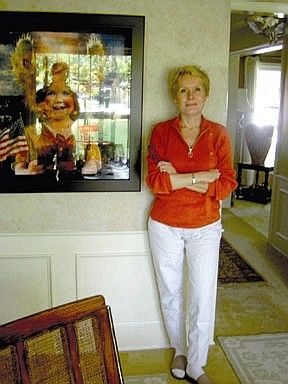Karen Thompson, the revered educator and
much-admired photographer, may have finally found
her la querencia, that place staked out in the
arena by the bullfighters to provide sanctuary
from the menacing charges of their adversary or,
in this case, the challenges of these difficult
times.
Don’t read that the wrong way. Although she’s
retiring after nearly 30 years of teaching at
IPFW and most recently at the University of Saint
Francis, the strikingly handsome and articulate
inspirer is just changing venues, not her life’s
work of documenting and storytelling.
To celebrate her exit and egress, the USF is
staging a Retrospective opening Saturday,
August 28 and running through October 2 at the
Weatherhead Gallery on campus. Retrospective
features some 50 pieces reflecting her
contribution to the visual arts, and it is a
humdinger.
Thompson was on the learn-as-you-go plan during
classes at the University of Iowa, and one of her
lessons realized after three years was that she
didn’t have what it takes to be an artist, at
least as measured by her accounting.
“My last semester in search of a degree included
photography, and it was then that I found my
medium. A 35mm Kodak Pony, if I remember
correctly, was my first camera, Thompson
recalled. In photography I found a release. Not
just a release from the labor-intensive work of
painting, printmaking, sculpture and ceramics,
but I was able to do more, maybe not better in
quality but more in quantity. And in all of that
I discovered a voice I was comfortable with. A
medium that allowed me to say what I was trying
to communicate.”
That period when alchemy reigned in pools of
chemicals and contact sheets gave way to
manipulating digitalized pixels some eight years
ago for Thompson. She was at once initially
intrigued and appalled. Maurice Papier, then the
Art Department chair at USF, announced that all
the instructors would be learning the new medium
together.
”I was so reluctant, and then even more so when
Maurice told me I was going to be teaching the
course. I think I spent time every day for an
entire year, plus workshops and seminars, to get
a grasp of the tools. To me it is like learning a
language (she studied several in college): first
you learn the alphabet, then its grammar, then
sentence structure, then conversation or dialog,
and finally you can tackle poetry,” Thompson
explained.
”The program (Photoshop) is really a time thief.
Like a bandit, it steals time,” Thompson
continued. “I remember once during that time my
teenage daughter briefly interrupted my work at
the computer at home to tell me she was going
out. When she opened the door and reappeared
before me, I thought she was coming back to pick
up her car keys or something she had forgotten.
It was then I realized she’d been gone for two
hours and I was still exploring some single
element of Photoshop.”
Since her apprenticeship Thompson has gone on to
master the nuances of the software and hone her
message. Like all artists she uses her skills to
focus the attention of her viewers. ”You’re not
always going to be with your art. You’re not
going to be there to narrate it,” she tells her
students, so it is critical that the work inform
itself.
“Therefore,” Thompson concludes, “exaggeration is sometimes necessary to get your
idea across.” To illustrate her point Thompson
related an episode involving her sister, who is,
shall we say vertically challenged.
”At family get-togethers the rest of us would
get down on her for hyping, even lying in the
telling of her stories. She responded with ‘When
you’re being interviewed for a position in a
chair across from a desk and your feet are
dangling above the carpet. What would you
do?”
TouchÈ!
As to the exhibit – it wasn’t to be hung until
after this article was due – I can only go by the
reproduced images in the well crafted four-color
invitation produced by Thompsons son-in-law,
Jeff Dollens of HPN, the marketing force for USF,
plus what I recall of her previously shown
works.
In many ways Thompson’s technique mimics the
medium of cut-out dolls. Remember the die-cut
paper costumes that children could dress figures
to stage historical or contemporary scenes by
folding tabs A, B and C? In Thompson’s modern
version she overlays costumes on images of her
favorite subject, her granddaughter, Isabel.
Often the scenes she creates depict those very
special places in the life of children and
perhaps can be best described in the words of
Elizabeth Goodenough in her book, Secret
Spaces of Childhood, a collection of stories
and poems which has been a favorite of the
artist.
“If you ever constructed a fort out of boxes,
chairs and blankets, or lost yourself in the
pages of a favorite book, you’ll recognize in
(Thompson’s) landscapes the urge we had as
children to hide out, build worlds within our
worlds and create spaces as real and potent as
any outside the limitless sphere of our younger,
inner lives.”
Thompson’s reflections capture the
daydream-like quality of our childhood visions
and fantasy worlds, a time when imagination had
yet to be banished from reality. To reconstruct
that special landscape … the gardens and
wildernesses-tender and terrible-of childhoods
heart.
This re-occurring theme of lost innocence
dominates her work. One piece, done in the
aftermath of 9/11, uses Isabel again as the
focus. In this case Thompson has cloaked her in a
Native American animal skin with a small American
flag in her grasp. Her rosey-cheeked and beaming
face is framed by a ring of leaves and large
moose antlers. In the background are grazing
sheep, cows and geese. Not quite your typical
Norman Rockwell.

